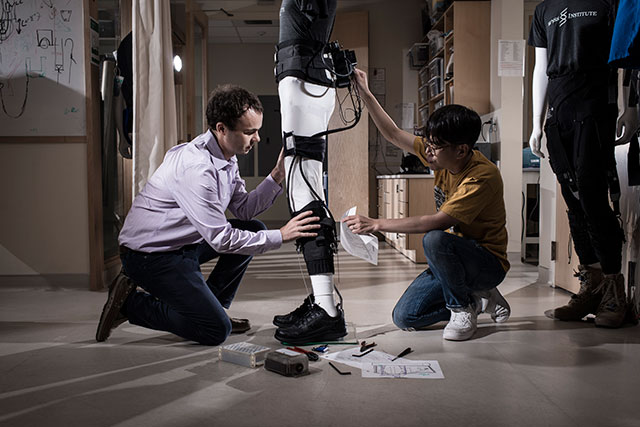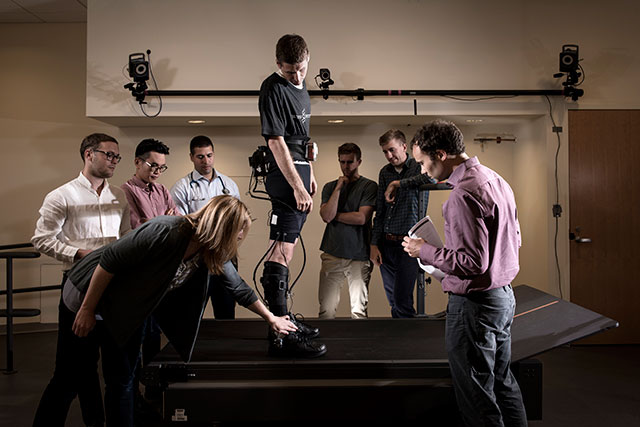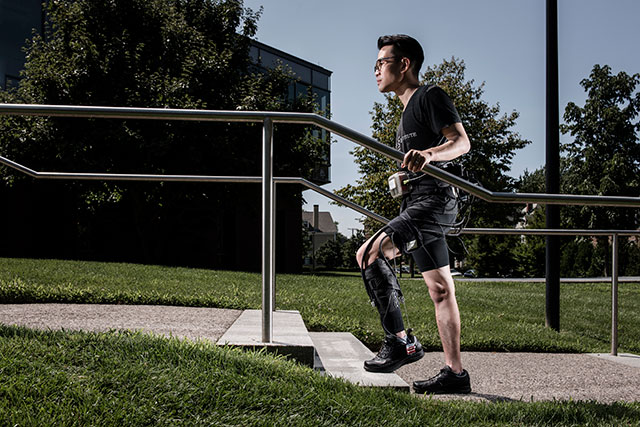Is your doctor and hospital in contact with them? How does this compare with these 6 posts on soft robotics? Or these 7 posts on soft exosuit? Or are they doing nothing at all with exoskeletons?
Post-stroke patients reach terra firma with exosuit technology
By Benjamin Boettner, The Wyss Institute
July 26, 2017
Upright walking on two legs is a defining trait in humans, enabling
them to move very efficiently throughout their environment. This can all
change in the blink of an eye when a stroke occurs. In about 80 percent
of patients post-stroke, it is typical that one limb loses its ability
to function normally — a clinical phenomenon called hemiparesis. And
even patients who recover walking mobility during rehabilitation retain
abnormalities in their gait that hinder them from participating in many
activities, pose risks of falls, and, because they impose a more
sedentary lifestyle, can lead to secondary health problems.
To help stroke patients regain their walking abilities, various robotics groups from industry and academia are developing powered wearable devices — so-called exoskeletons — that can restore gait functions or assist with rehabilitation. Historically, these systems restricted patients to a treadmill in a clinical setting, but in recent years portable systems have been developed that enable walking overground. Working towards the long-term goal of developing soft wearable robots that can be worn as clothing, researchers at the Harvard John A. Paulson School of Engineering and Applied Sciences (SEAS), the Wyss Institute for Biologically Inspired Engineering, and Boston University’s (BU) College of Health & Rehabilitation Sciences: Sargent College have developed a lightweight, soft, wearable ankle-assisting exosuit that could help reinforce normal gait in people with hemiparesis after stroke.
In previous studies performed in healthy people, the team demonstrated that their exosuit technology can deliver assistive forces during walking and jogging and that they produce marked reductions in energy costs. Now, in a new study published in Science Translational Medicine, a research team led by Conor Walsh collaborating with BU faculty members Terry Ellis, Lou Awad, and Ken Holt have demonstrated that exosuits also can be used to improve walking after stroke — a critical step in de-risking exosuit technology towards real-world clinical use.

Patients recovering from a stroke develop compensatory walking strategies to deal with their inability to clear the ground with their affected limb and to push off at the ankle during forward movement. Typically, they have to lift their hips (hip hiking) or move their foot in an outward circle forward (circumduction) rather than in a straight line during walking. Usually, rigid plastic braces worn around the ankle are prescribed to help with walking, but they do not help overcome these abnormal gait patterns and about 85 percent of people who suffered a stroke retain elements of their gait abnormalities.
“Current approaches to rehabilitation fall short and do not restore the mobility that is required for normal life,” said Ellis, Director of the Center for Neurorehabilitation at BU’s College of Health & Rehabilitation Sciences: Sargent College and Assistant Professor at BU.
In the new study, the team asked whether the exosuit’s beneficial impact on gait mechanics and energy expenditure during walking they observed in healthy people would also be observed in patients post-stroke who were recruited and enrolled in the study with the help of the Wyss Institute’s Clinical Research Team.
 Exosuits are anchored to the affected limb of a hemiparetic stroke
patient via functional apparel, and they provide gait-restoring forces
to the ankle joint by transferring mechanical power via a cable-based
transmission from battery-powered actuators that are integrated into a
hip belt or an off-board cart located next to a treadmill.
Exosuits are anchored to the affected limb of a hemiparetic stroke
patient via functional apparel, and they provide gait-restoring forces
to the ankle joint by transferring mechanical power via a cable-based
transmission from battery-powered actuators that are integrated into a
hip belt or an off-board cart located next to a treadmill.
“In treadmill experiments we found that a powered exosuit improved the walking performance of seven post-stroke patients, helping them to clear the ground and push off at the ankle, thus generating more forward propulsion,” said Jaehyun Bae, a co-first author on the study and graduate student at SEAS.
The team also observed a reduced functional asymmetry between the paretic and non-paretic limbs of participants and found that the exosuit’s assistance enabled them to walk more efficiently.
Because walking mechanics and dynamics differ between controlled walking on a treadmill and walking overground in the home or communal environment, the team went on to assess exosuit-provided benefits in an overground walking experiment.
 The picture above does not look like a stroke survivor, left hand looks fully functional.
The picture above does not look like a stroke survivor, left hand looks fully functional.
“It was extremely encouraging to see that an untethered exosuit also had the ability to facilitate more normal walking behavior during overground walking. This is a key step toward developing exosuits as rehabilitation devices for patients to use outside of the clinic and in their normal lives,” said Lou Awad, the study’s other co-first author, who at the time of the study was a postdoctoral fellow with Walsh and since has become an Associate Faculty member at the Wyss Institute and Assistant Professor at BU’s College of Health and Rehabilitation: Sargent College.
“In an ideal future, patients post-stroke would be wearing flexible adjusting exosuits from the get-go to prevent them from developing inefficient gait behaviors in the first place,” said Ellis.
The study was also authored by Kenneth Holt, Associate Professor at BU’s College of Health & Rehabilitation Sciences: Sargent College, former and current members on Walsh’s team Stefano De Rossi, Lizeth Sloot, Pawel Kudzia, and Stephen Allen, as well as Katy Hendron, N.C.S., who worked in Ellis’ group at BU.
The study was supported by a Defense Advanced Research Projects Agency (DARPA) Warrior Web Program, grants from the National Science Foundation, the American Heart Association and the National Institutes of Health, a Rolex Award for Enterprise, a Harvard University Star Family Challenge, as well as Wyss Institute and SEAS funding.
To help stroke patients regain their walking abilities, various robotics groups from industry and academia are developing powered wearable devices — so-called exoskeletons — that can restore gait functions or assist with rehabilitation. Historically, these systems restricted patients to a treadmill in a clinical setting, but in recent years portable systems have been developed that enable walking overground. Working towards the long-term goal of developing soft wearable robots that can be worn as clothing, researchers at the Harvard John A. Paulson School of Engineering and Applied Sciences (SEAS), the Wyss Institute for Biologically Inspired Engineering, and Boston University’s (BU) College of Health & Rehabilitation Sciences: Sargent College have developed a lightweight, soft, wearable ankle-assisting exosuit that could help reinforce normal gait in people with hemiparesis after stroke.
In previous studies performed in healthy people, the team demonstrated that their exosuit technology can deliver assistive forces during walking and jogging and that they produce marked reductions in energy costs. Now, in a new study published in Science Translational Medicine, a research team led by Conor Walsh collaborating with BU faculty members Terry Ellis, Lou Awad, and Ken Holt have demonstrated that exosuits also can be used to improve walking after stroke — a critical step in de-risking exosuit technology towards real-world clinical use.

Conor Walsh and his Graduate Student
Jaehyun Bae fine-tuning an ankle-assisting exosuit. (Image courtesy
of Rolex Awards/Fred Merz)
“This foundational study shows that soft wearable robots can have
significant positive impact on gait functions in patients post-stroke,
and it is the result of a translational-focused multidisciplinary team
of engineers, designers, biomechanists, physical therapists and most
importantly patients who volunteered for this study and gave valuable
feedback that guided our research,” said Walsh, the John L. Loeb
Associate Professor of Engineering and Applied Sciences at SEAS, Wyss
Core Faculty member and the founder of the Harvard Biodesign Lab.Patients recovering from a stroke develop compensatory walking strategies to deal with their inability to clear the ground with their affected limb and to push off at the ankle during forward movement. Typically, they have to lift their hips (hip hiking) or move their foot in an outward circle forward (circumduction) rather than in a straight line during walking. Usually, rigid plastic braces worn around the ankle are prescribed to help with walking, but they do not help overcome these abnormal gait patterns and about 85 percent of people who suffered a stroke retain elements of their gait abnormalities.
“Current approaches to rehabilitation fall short and do not restore the mobility that is required for normal life,” said Ellis, Director of the Center for Neurorehabilitation at BU’s College of Health & Rehabilitation Sciences: Sargent College and Assistant Professor at BU.
In the new study, the team asked whether the exosuit’s beneficial impact on gait mechanics and energy expenditure during walking they observed in healthy people would also be observed in patients post-stroke who were recruited and enrolled in the study with the help of the Wyss Institute’s Clinical Research Team.

The multidisciplinary team of engineers,
designers, biomechanists and physical therapist discussing progress on
the exosuit. (Image courtesy of Rolex Awards/Fred Merz)
“In treadmill experiments we found that a powered exosuit improved the walking performance of seven post-stroke patients, helping them to clear the ground and push off at the ankle, thus generating more forward propulsion,” said Jaehyun Bae, a co-first author on the study and graduate student at SEAS.
The team also observed a reduced functional asymmetry between the paretic and non-paretic limbs of participants and found that the exosuit’s assistance enabled them to walk more efficiently.
Because walking mechanics and dynamics differ between controlled walking on a treadmill and walking overground in the home or communal environment, the team went on to assess exosuit-provided benefits in an overground walking experiment.

The ankle-assisting exosuit can facilitate normal overground walking. (Image courtesy of Rolex Awards/Fred Merz)
“It was extremely encouraging to see that an untethered exosuit also had the ability to facilitate more normal walking behavior during overground walking. This is a key step toward developing exosuits as rehabilitation devices for patients to use outside of the clinic and in their normal lives,” said Lou Awad, the study’s other co-first author, who at the time of the study was a postdoctoral fellow with Walsh and since has become an Associate Faculty member at the Wyss Institute and Assistant Professor at BU’s College of Health and Rehabilitation: Sargent College.
In an
ideal future, patients post-stroke would be wearing flexible adjusting
exosuits from the get-go to prevent them from developing inefficient
gait behaviors in the first place.Tweet This
In ongoing and future research the team is looking to further
personalize exosuit assistance to specific gait abnormalities,
investigate assistance at other joints such as the hip and knee, and
assess longer-term therapeutic effects of their technology. In addition
to this research, Wyss Institute staff member Kathleen O’Donnell leads
the Wyss Institute’s efforts to translate the technology to the clinic
with industrial partner ReWalk Robotics.“In an ideal future, patients post-stroke would be wearing flexible adjusting exosuits from the get-go to prevent them from developing inefficient gait behaviors in the first place,” said Ellis.
The study was also authored by Kenneth Holt, Associate Professor at BU’s College of Health & Rehabilitation Sciences: Sargent College, former and current members on Walsh’s team Stefano De Rossi, Lizeth Sloot, Pawel Kudzia, and Stephen Allen, as well as Katy Hendron, N.C.S., who worked in Ellis’ group at BU.
The study was supported by a Defense Advanced Research Projects Agency (DARPA) Warrior Web Program, grants from the National Science Foundation, the American Heart Association and the National Institutes of Health, a Rolex Award for Enterprise, a Harvard University Star Family Challenge, as well as Wyss Institute and SEAS funding.
No comments:
Post a Comment